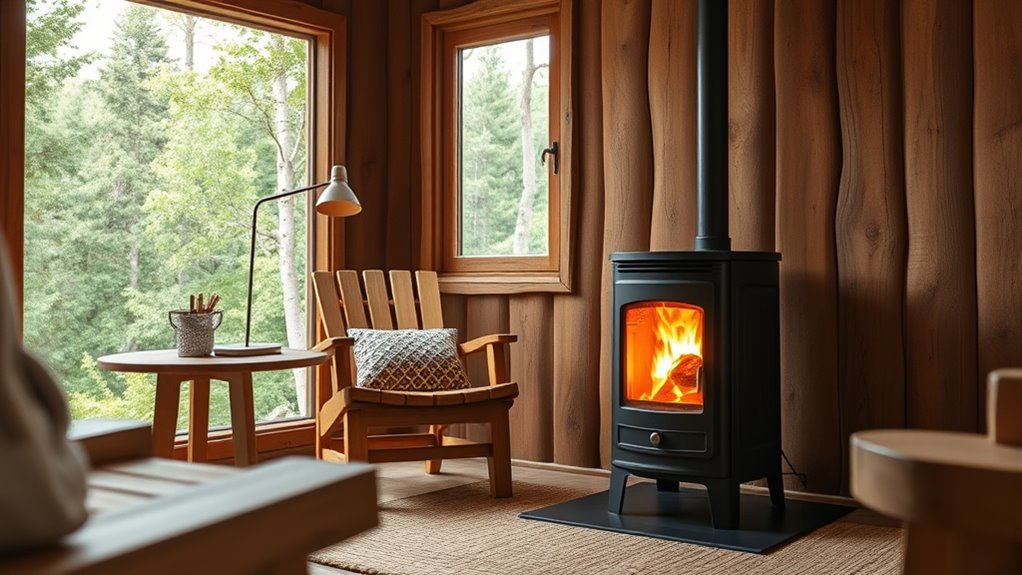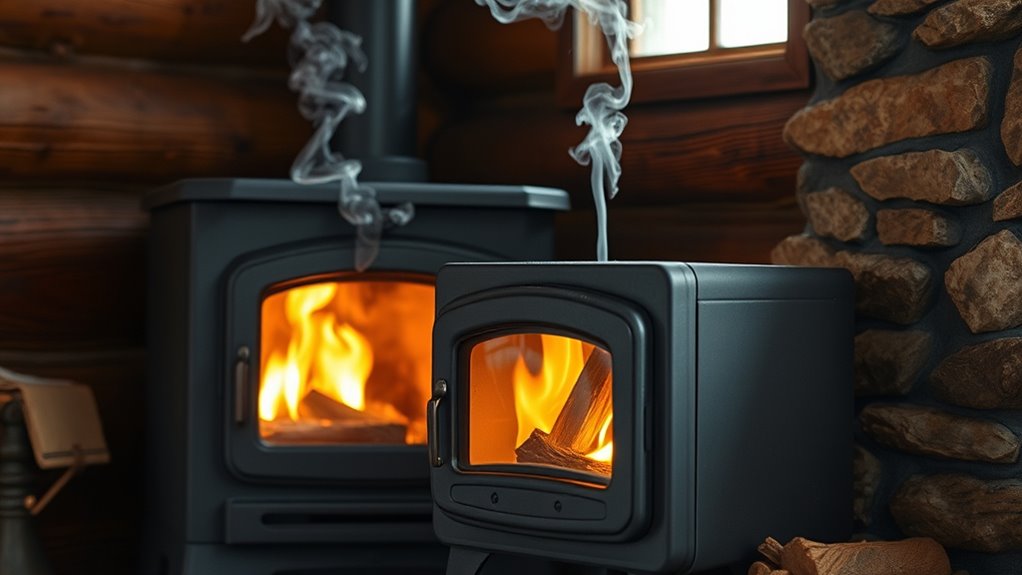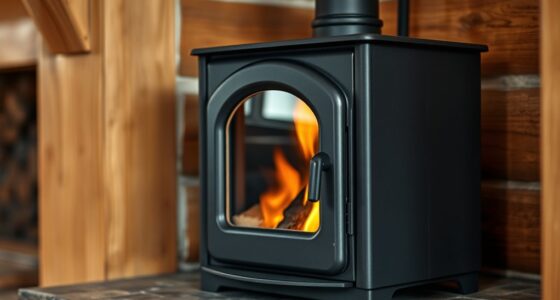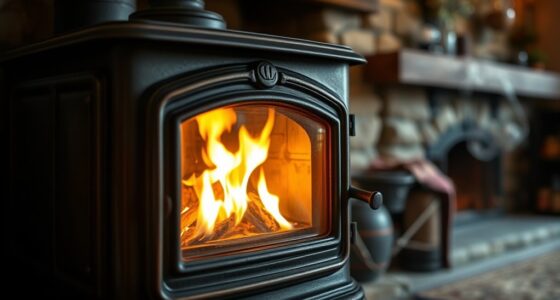Small wood stoves can be eco-friendly if you use them responsibly. When you choose modern, EPA-certified models and burn sustainably sourced, seasoned wood, they produce fewer emissions and support renewable energy. Proper maintenance and operation help minimize pollutants while maximizing efficiency. By following best practices, you can reduce your carbon footprint and enjoy clean, sustainable heating. If you want to learn how to make sure your stove is eco-friendly, keep exploring these important tips.
Key Takeaways
- Small wood stoves use renewable biomass, producing lower net greenhouse gases compared to fossil fuels.
- Modern, EPA-certified stoves incorporate advanced tech to minimize particulate and pollutant emissions.
- Proper sourcing of sustainably harvested, seasoned wood ensures cleaner combustion and environmental friendliness.
- Regular maintenance and correct operation optimize efficiency and further reduce smoke and pollutants.
- They support decentralized energy use, reducing reliance on fossil fuel power plants and promoting sustainable energy practices.

Are small wood stoves truly eco-friendly options for heating your home? Many people consider these stoves an attractive choice because they use renewable energy from biomass, which can be replenished sustainably. Unlike fossil fuels, wood is a renewable resource if harvested responsibly, making it an appealing option for those aiming to reduce their carbon footprint. When you burn wood in a well-designed stove, you’re tapping into a natural cycle where trees absorb carbon dioxide as they grow, which is then released back into the atmosphere during combustion. Ideally, this process results in a relatively low net increase in greenhouse gases, especially when compared to non-renewable energy sources like coal or oil.
Small wood stoves offer a renewable, low-carbon heating option when used responsibly and maintained properly.
The key to making small wood stoves more eco-friendly lies in emissions reduction. Modern stoves are engineered with advanced combustion technology that considerably cuts down on harmful pollutants like particulate matter, carbon monoxide, and volatile organic compounds. These innovations guarantee that you’re not only heating your home efficiently but also minimizing the environmental impact. Proper operation and regular maintenance are essential, as dirty or improperly used stoves can produce more smoke and emissions, negating their environmental benefits. When you choose an EPA-certified stove, you’re investing in a device that meets strict standards for cleaner combustion, further supporting emissions reduction.
Furthermore, small wood stoves can contribute to a decentralized energy model, where power isn’t solely dependent on large-scale power plants that may burn fossil fuels. This decentralization can reduce transmission losses and reliance on grid electricity, which often involves substantial emissions. Using a small stove for heating complements renewable energy strategies by utilizing locally sourced wood, which can often be harvested sustainably in your region. As you opt for responsibly sourced wood and maintain your stove properly, you’re participating in a cycle that’s more environmentally conscious than many conventional heating methods. Additionally, incorporating solar energy solutions can further enhance your eco-friendly energy use, reducing your overall reliance on combustion-based heating.
It is also worth noting that certified wood can significantly influence the environmental friendliness of your stove, as certified sources ensure sustainable harvesting practices. Moreover, choosing seasoned, dry wood increases combustion efficiency and reduces smoke emissions. Properly stored wood also prevents excess moisture that can lead to incomplete combustion and increased pollution. However, it’s important to recognize that not all wood stoves are equally eco-friendly. Cheaper models or outdated designs may produce excessive smoke and emissions, diminishing their benefits. To truly harness the potential of small wood stoves as eco-friendly heating options, you should prioritize high-efficiency models and follow best practices for burning wood—like using seasoned, dry wood and ensuring proper airflow. When used correctly, small wood stoves become a practical, renewable energy-based heating solution that supports emissions reduction efforts, helps lower your carbon footprint, and promotes sustainable living.
Frequently Asked Questions
How Do Small Wood Stoves Compare to Other Eco-Friendly Heating Options?
Small wood stoves are generally eco-friendly compared to other heating options because they use renewable energy, reducing reliance on fossil fuels. They produce less emissions when properly maintained, making them a sustainable choice. In a cost comparison, small wood stoves often cost less upfront and have lower operating costs than electric or gas systems. You can enjoy efficient, eco-conscious heating while saving money and reducing your carbon footprint.
Are There Specific Certifications to Look for in Eco-Friendly Small Wood Stoves?
Think of certifications as a lighthouse guiding you through eco-friendly choices. Look for small wood stoves with certification standards like EPA (Environmental Protection Agency) or CSA (Canadian Standards Association), which guarantee they meet strict eco label requirements. These standards verify that the stove burns efficiently, reduces emissions, and is environmentally friendly. Choosing a certified stove helps you stay on the right path toward greener heating while keeping your home cozy.
What Maintenance Practices Ensure a Small Wood Stove Remains Eco-Friendly?
To keep your small wood stove eco-friendly, prioritize regular chimney cleaning to prevent creosote buildup, which improves wood stove efficiency. Use properly seasoned, dry wood to reduce smoke and emissions. Avoid overloading the stove, and ensure the door seals tightly. Conduct annual inspections of the stove and chimney system, and consider upgrades or certifications that enhance efficiency. These practices help your stove burn cleaner and stay environmentally friendly.
Can Small Wood Stoves Reduce Overall Household Carbon Footprint?
Yes, small wood stoves can reduce your household carbon footprint by utilizing renewable fuel sources. They improve air quality when properly maintained, emitting fewer pollutants. Choosing stoves made from sustainable materials also supports material sustainability. By optimizing efficiency and burning responsibly, you minimize emissions, lowering your overall environmental impact and contributing to a healthier planet. Proper operation and maintenance are key to maximizing these eco-friendly benefits.
Are Eco-Friendly Small Wood Stoves Suitable for All Climate Zones?
Eco-friendly small wood stoves can suit various climate zones, but their climate adaptability depends on proper sizing and insulation. You might face installation challenges in colder areas where additional heating sources are necessary. In milder climates, these stoves work well, providing efficient heating without excessive emissions. To guarantee effectiveness, assess your local climate conditions and consult professionals to address installation challenges, making sure your eco-friendly choice meets your home’s needs.
Conclusion
So, are small wood stoves really eco-friendly? They can be a greener choice if you use sustainably sourced wood and operate them efficiently. But think about it—would you prefer a cozy, renewable heat source that reduces your carbon footprint or continue relying on fossil fuels? Ultimately, making mindful choices about how you heat your home can make a difference. Isn’t it worth considering a small wood stove as a step toward a more sustainable lifestyle?











